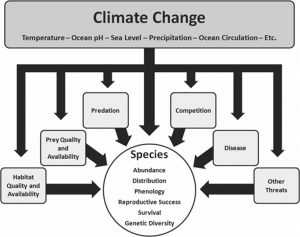How Climate Change Affects Marine Species, their Environments and the U.S. Endangered Species Act
By Jacob Jerome, RJD Intern
Despite a frigid winter in a large portion of the U.S., global climate change is upon us and average global temperatures are increasing. Many of us think about how climate change will affect us personally, but forget that it affects marine species too, especially those that are threatened or endangered. Seney et al published a paper in 2013 that reviewed the potential effects that climate change poses on species and ecosystems, and how it effects decision making under the Endangered Species Act (ESA).
Worldwide climate change documentation indicates mean surface air temperatures are increasing, along with the upper layers of the ocean. Due to our growing planet, the abundance of carbon dioxide in the atmosphere has caused the surface waters of the oceans to become more acidic. With this type of data, projections have been made to see how our climate will change in the 21st century. Assuming no reduction in carbon emissions, it is predicted that surface air temperatures will increase even more, the sea level will rise, and the pH of the ocean will continue to drop.
These environmental changes can affect species through habitat loss or alteration, distribution changes, geographic isolation, or changes in predator-prey interactions. Even human adaptations to climate change such as relocation or changes in fishing and agriculture could potentially impact species through habitat conversion and ecological degradation.

Schematic showing the multiple interactions among species, their ecosystems, and climate effects (Seney et al., 2013).
So what does all this mean for the conservation and management of marine species? In 1973 the United States implemented the Endangered Species Act (ESA) in an effort to prevent species’ extinction and promote their recovery. While this continues to be one of the United States’ best laws protecting various species, it was not originally intended to factor in climate change. Luckily, the ESA emphasizes the importance of habitats and ecosystems to endangered and threatened species and therefore can afford protection in the event of climate change. To make this happen, climate change needs to be considered in five key ESA decisions: listing determinations, designation of critical habitat, recovery planning, accessing and mitigating effects of proposed federal actions, and issuance of incidental take permits. These decisions for marine species fall to the National Marine Fisheries Service (NMFS) of the National Oceanic and Atmospheric Administration (NOAA).
Listing determinations refers to how a species’ status is determined, whether threatened or endangered. According to the ESA, an endangered species “is in danger of extinction throughout all or a significant portion of its range” and a threatened species “is likely to become an endangered species within the foreseeable future throughout all or a significant portion of its range.” Climate change can affect listing decisions if it can present new threats that affect species persistence or add to existing threats.
Critical habitat of listed species is “physical or biological features essential to the conservation of the species and which may require special management considerations or protection.” The boundaries of critical habitat for species could change for those that modify their range when reacting to climate change. To better address this, agencies should look outside currently occupied spaces for essential habitat in the event of climate change.

Rising air temperatures are causing glaciers in the north to break apart and melt, a contributing factor to the rise in sea level. (Thomas Hallermann/Marine Photobank)
Recovery planning takes place for every species that is listed under the ESA, making it vital for agencies to provide guidelines on how to promote the recovery of species. Climate change was not addressed in past recovery plans, but since 2008, over half of the recovery plans drafted included climate change — information that is imperative when working to conserve the most endangered species.
When federal actions are proposed, conservation planners look to see how the action will affect species and their ecosystems. While it is difficult, projecting how those actions will look after climate change would help to better protect species against potentially harmful actions.
If agencies provide permits that allow the take of ESA listed species in connection with certain activities, they must consider the effects of climate change on future environmental conditions when determining the approval of a permit. This will help to ensure that the permit does not add a higher degree of risk to the species’ survival.
Through these actions, we may be able to strengthen the ESA, allowing even better protection for threatened and endangered species.
Reference
Seney, E.E., Rowland, M.J., Lowery, R.A., Griffis, R.B., and McClure, M.M. “Climate Change, Marine Environments, and the U.S. Endangered Species Act.” Conservation Biology. 27.6 (2013): 1138-1146.
